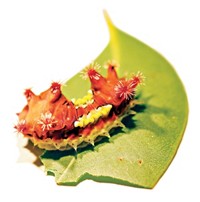Advertisement
Grab your lab coat. Let's get started
Welcome!
Welcome!
Create an account below to get 6 C&EN articles per month, receive newsletters and more - all free.
It seems this is your first time logging in online. Please enter the following information to continue.
As an ACS member you automatically get access to this site. All we need is few more details to create your reading experience.
Not you? Sign in with a different account.
Not you? Sign in with a different account.
ERROR 1
ERROR 1
ERROR 2
ERROR 2
ERROR 2
ERROR 2
ERROR 2
Password and Confirm password must match.
If you have an ACS member number, please enter it here so we can link this account to your membership. (optional)
ERROR 2
ACS values your privacy. By submitting your information, you are gaining access to C&EN and subscribing to our weekly newsletter. We use the information you provide to make your reading experience better, and we will never sell your data to third party members.
Biological Chemistry
Fangblenny bite delivers opiod-containing venom that drops blood pressure and ignites inflammation in victims
The colorful, inauspicious fish evolved its fangs before its venom-making skills
by Sarah Everts
April 3, 2017
| A version of this story appeared in
Volume 95, Issue 14
If a predator fish tries to swallow a tiny fangblenny, the hunter receives such a compelling dose of venom from its prospective lunch that the larger fish quivers and opens its mouth, letting the fangblenny escape unharmed. When Nicholas R. Casewell of the Liverpool School of Tropical Medicine, Bryan G. Fry of the University of Queensland, and colleagues took a close look at venomous fangblennies of the Meiacanthus genus, they discovered that the fish’s propensity to deliver toxic deterrents has some peculiar attributes (Curr. Biol. 2017, DOI: 10.1016/j.cub.2017.02.067). For example, many fish that use venom for defense rely on sharp spines to deliver their cargo; the fangblenny uses fangs. Furthermore, venomous fangblennies evolved their fangs before they evolved the biochemical ability to produce venom. Initially, the fish may have used the fangs to scoop out the flesh of competitors or to give predators a sharp poke. The team also discovered that fangblenny venom contains potent phospholipases that chop up membranes to cause inflammation. These enzymes are common constituents of bee, scorpion, and snake venom, and the activity of fangblenny phospholipases is on par with that of pit viper snake phospholipases. The venom also contains neuropeptides and proenkephalin, a peptide that targets opioid receptors. These latter two components make a victim’s blood pressure plummet and may interfere with coordination and swimming—outcomes that would certainly facilitate the fangblenny’s escape.





Join the conversation
Contact the reporter
Submit a Letter to the Editor for publication
Engage with us on Twitter